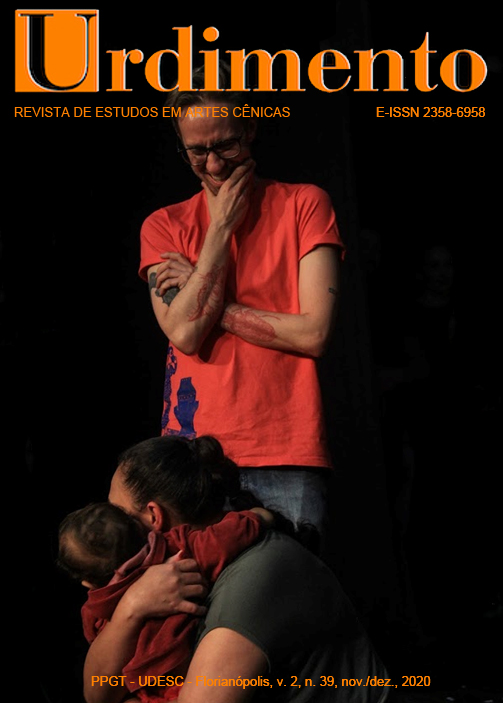What happens when I look at you: the intimate space of prison theater
DOI:
https://doi.org/10.5965/14145731033920200110Palavras-chave:
Teatro na prisão, Artes prisionais, Voluntários na prisão, Reabilitação, Artes em correçõesResumo
Despite the burgeoning literature on theater and volunteers in prisons, there is little research that looks at the prison theater experience through the eyes of both the outside volunteers and the prisoner-participants. This article seeks to weave together the voices of the co-authors in order to explore shared experiences of the prison theater classroom. These experiences – variously described as ‘magical’ and ‘transcendent’ – are dependent on the volunteer successfully navigating entry into the prison. The space of the prison theater classroom then becomes a relational refuge where both prisoners and volunteers can feel welcome and accepted, seen not as other but as essential.
Downloads
Referências
ABBOTT, J. H. In the Belly of the Beast: Letters from Prison. New York: Vintage Books, 1978.
ABRAMS, L., HUGHES, E., INDERBITZIN, M., & MEEK, R. (Eds.) The Voluntary Sector in Prisons: Encouraging Personal and Institutional Change. London: Palgrave Studies, 2016.
ARMSTRONG, R. Trusting the untrustworthy: the theology, practice, and implications of faith-based volunteers’ work with ex-prisoners. Studies in Christian Ethics, v. 27, n. 3, p. 299-317, 2014.
BREWSTER, L. The impact of prison arts programs on inmate attitudes and behavior: a quantitative evaluation. Justice Policy Journal, v. 11, n. 2, p. 1-28, 2014.
CHELIOTIS, L. (Ed.). The Arts of Imprisonment: Control, Resistance and Empowerment. Ashgate Publishing, 2012.
COHEN-CRUZ, J. Engaging Performance: Theatre as Call and Response. Florence: Routledge, 2010.
CREWE B., WARR, J., BENNETT, P., SMITH A. The emotional geography of prison life. Theoretical Criminology, v. 18, n. 1, p. 56-74, 2014.
CULLEN, F. The twelve people who saved rehabilitation: how the science of criminology made a difference. Criminology, v. 43, n. 1, p. 1-42, 2005.
DILLARD, A. The Writing Life. New York: Harper Perennial, 2013.
DWECK, C. Mindset: The New Psychology of Success. New York: Ballantine Books, 2006.
FESETTE, N. & LEVITT, B. Pedagogies of self-humanization: collaborating to engage trauma in the Phoenix Players Theatre Group. Teaching Artist Journal, v. 15, n. 3-4, p. 100-113, 2017.
FOUCAULT, M. Discipline and Punish: The Birth of the Prison. New York: Pantheon, 1977.
FOUCHÉ, C., & LUNT, N. Nested mentoring relationship: reflections on a practice project for mentoring research capacity amongst social work practitioners. Journal of Social Work, v. 10, n. 4, p. 391-406, 2010.
FREIRE, P. Pedagogy of the Oppressed. New York: Continuum International Publishing Group, 1970.s
GOFFMAN, E. Asylums: Essays on the social situation of mental patients and other inmates. New York: Anchor Books, 1961.
HAMER, K. Navigating boundaries, weaving worlds: U.S. practitioners’ experiences of running theatre programmes in prisons. Cambridge, 2019. Thesis (Masters) – University of Cambridge.
LIEBLING, A. Can human beings flourish in prison? PPT Lecture, London, 29th May, 2012. Available at <http://www.artsevidence.org.uk/media/uploads/evaluation-downloads/can-human-beings-flourish-in-prison---alison-liebling---may-2012.pdf>.
LUCAS, A. Prison Theatre and the Global Crisis of Incarceration. New York: Methuen Drama, 2020.
MORAN D. Carceral geography and the spatialities of prison visiting: visitation, recidivism, and hyperincarceration. Environment and Planning D: Society & Space,
v. 31, n. 1, p. 174-190, 2013.
SIMPSON, E., MORGAN, C., & CAULFIELD, L. S. From the outside in: narratives of creative arts practitioners working in the criminal justice system. The Howard Journal of Criminal Justice, v. 58, n. 3, p. 384-403, 2019.
SMITH, C. What is a Person? Rethinking Humanity, Social Life, and the Moral Good from the Person Up. University of Chicago Press, 2010.
TEWKSBURY, R. & COLLINS, S. Prison chapel volunteers, Federal Probation, v. 69, n. 1, p. 26–30, 2005.
TEWKSBURY, R. & DABNEY, D. Prison volunteers: profiles, motivations, satisfaction. Journal of Offender Rehabilitation, v. 40, n. 1-2, p. 173-183, 2004.
TOFTELAND, C. The Keeper of the Keys. In: SHAILOR, J (Ed.) Performing New Lives: Prison Theater. London: Jessica Kingsley Publishers Ltd., 2011, p. 213-230.
TOMCZAK, P., & ALBERTSON, K. Prisoner relationships with voluntary sector practitioners. The Howard Journal of Crime and Justice, v. 55, n. 1–2, p. 57-72, 2016.
TURNER, V. Liminal to liminoid, in play, flow, and ritual: an essay in comparative symbology. Mediações: Revista de Ciências Sociais, v. 17, n. 2, p. 214–257, 2012.
VAN DER KOLK, B. A. The Body Keeps the Score: Brain, Mind, and Body in the Healing of Trauma. New York, NY: Penguin Books, 2014.
VAN MAANEN, K. Miss Spent: A drama project for young women at the Josephine Butler Unit, HMP Downview. Evaluation Report. Available at: <http://www.clinks.org/assets/ files/Miss%20Spent%20report%20final.pdf>.
ZELON, H. The Shakespeare redemption: Inmates in a Kentucky prison grapple with the truths of human existence. American Theatre v. 18, no. 8, p. 32–135, 2001.
Downloads
Publicado
Como Citar
Edição
Seção
Licença
Copyright (c) 2020 Urdimento - Revista de Estudos em Artes Cênicas

Este trabalho está licenciado sob uma licença Creative Commons Attribution 4.0 International License.
Declaração de Direito Autoral
Os leitores são livres para transferir, imprimir e utilizar os artigos publicados na Revista, desde que haja sempre menção explícita ao(s) autor (es) e à Urdimentoe que não haja qualquer alteração no trabalho original. Qualquer outro uso dos textos precisa ser aprovado pelo(s) autor (es) e pela Revista. Ao submeter um artigo à Urdimento e tê-lo aprovado os autores concordam em ceder, sem remuneração, os seguintes direitos à Revista: os direitos de primeira publicação e a permissão para que a Revista redistribua esse artigo e seus meta dados aos serviços de indexação e referência que seus editores julguem apropriados.
Este periódico utiliza uma Licença de Atribuição Creative Commons– (CC BY 4.0)




